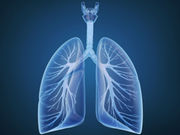Adjusted RV-end-systolic-volume-index, relative area change of pulmonary artery predict death
MONDAY, April 3, 2017 (HealthDay News) — Magnetic resonance imaging (MRI) measures can predict outcomes in pulmonary arterial hypertension (PAH), according to a study published online March 22 in the American Journal of Respiratory and Critical Care Medicine.
Andrew J. Swift, Ph.D., from the University of Sheffield in the United Kingdom, and colleagues studied 576 patients with PAH undergoing MRI during a follow-up period of 42 months. The patients were divided into a derivation cohort (288 patients, 115 deaths) and a validation cohort (288 patients, 106 deaths).
The researchers found that right ventricular (RV)-end-systolic-volume-index adjusted for age and sex and the relative area change of the pulmonary artery were independent MRI predictors of death. Based on the derivation cohort, a model of MRI and clinical data was able to predict mortality in the validation cohort at one year (sensitivity, 70; specificity, 62; positive predictive value [PPV], 24; and negative predictive value [NPV], 92) and at three years (sensitivity, 77; specificity, 73; PPV, 56; and NPV, 87). The accuracy of the model was greater for patients with idiopathic PAH at three years (sensitivity, 89; specificity, 76; PPV, 60; and NPV, 94).
“MRI measurements reflecting RV structure and stiffness of the proximal pulmonary vasculature are independent predictors of outcome in PAH,” the authors write. “In combination with clinical data, MRI has moderate prognostic accuracy in the evaluation of patients with PAH.”
One author disclosed financial ties to Bayer.
Copyright © 2017 HealthDay. All rights reserved.








